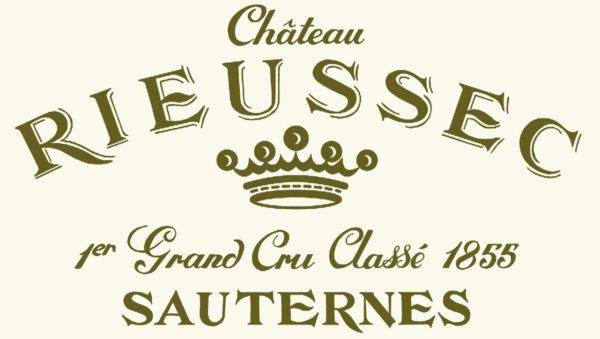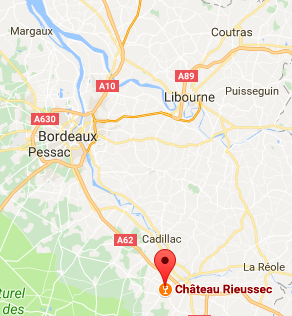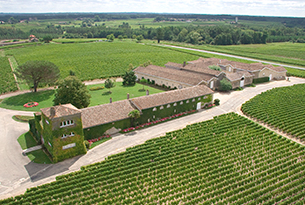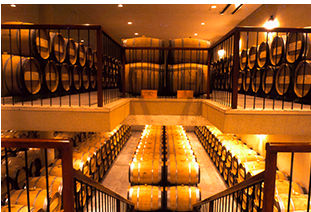
History
For the 1855 classification, M. Mayne was the owner of the estate. The quality of the Rieussec soil earned its ranking as a first growth Sauternes and Barsac. After that date, Rieussec’s history involves many changes of owners: Charles Crepin (around 1870), Paul Defolie (1892), Mr. Bannil (1907), then the Gasqueton family (owner of Château Calon-Ségur at Saint Estèphe), P.F. Berry during the war (an American citizen and brother-in-law of the Vicomte de Bouzet), Mr. Balaresque (1957) and lastly, Albert Vuillier (1971), who was passionate about Sauternes’ “sweet wines”.
Rieussec soil earned its ranking as a first growth Sauternes and Barsac. After that date, Rieussec’s history involves many changes of owners: Charles Crepin (around 1870), Paul Defolie (1892), Mr. Bannil (1907), then the Gasqueton family (owner of Château Calon-Ségur at Saint Estèphe), P.F. Berry during the war (an American citizen and brother-in-law of the Vicomte de Bouzet), Mr. Balaresque (1957) and lastly, Albert Vuillier (1971), who was passionate about Sauternes’ “sweet wines”.
Château Rieussec was acquired by Domaines Barons de Rothschild (Lafite) in 1984. The estate then consisted of 110 hectares, 68 hectares of which were vines. To enhance Château Rieussec’s potential, rigorous measures were implemented, including meticulous sorting of the grapes and fermenting in barrels, which provides a much finer selection for the blending of the Grand Vin.
A new cellar was built in 1989 to extend the ageing period in barrels. The quantities of the Grand Vin that were produced were much reduced in the 1990’s due to more meticulous selection, to the point that none at all was produced in 1993 (this was also the case in 1977 and again in 2012).
In 2000, the renovation of the maturing cellar, the construction of a fermentation room, and the modernisation of the reception and pressing areas also represented strides forward in a quality policy that was launched in 1985.
The first attempts at selection were rewarded by a remarkable trio of vintages in 1988, 1989 and 1990. This was crowned by an entire decade of very good wines from 1995 to 2005. The weather proved to be no obstacle for the remarkable vintages of 1996, 1997, 1999, 2001, 2003 and 2005, among others! Furthermore, Château Rieussec 2001 was declared Wine of the Year in 2004 by Wine Spectator magazine.
The Terroir
 The Château Rieussec vineyard extends to the border of Fargues and Sauternes, and adjoins Château d’Yquem. Rieussec is one of the largest properties in Sauternes and Barsac, the vineyard covers 93 hectares of gravelly sandy-clay soil.
The Château Rieussec vineyard extends to the border of Fargues and Sauternes, and adjoins Château d’Yquem. Rieussec is one of the largest properties in Sauternes and Barsac, the vineyard covers 93 hectares of gravelly sandy-clay soil.
The iconic grape variety of Sauternes, Sémillon, dominates (90%), followed by Sauvignon (7%) and Muscadelle (3%). Traditional Sauternes techniques are used and the harvests are carried out with selective pickings depending on the ripeness of the grapes and evolution of botrytis cinerea (noble rot). They last for 6 to 8 weeks from September to November.
Production is low and firmly in the hands on Mother Nature. The traditional saying is that a single vine should produce a bottle of wine. Here, though, a single vine produces about a glass of wine!
The vineyard is managed by Eric Kohler, Technical Director of the Bordeaux Châteaux, with the help of Jean de Roquefeuil, Vineyard Manager, and Serge Lagardère, Cellar Master.
Vinification
 Wines are fermented in barrels. The yields are sorted and each parcel is identified and isolated in a batch of barrels, in order to judge whether or not it can be used in the Grand Vin after fermentation. Several tastings from each barrel are then performed in order to ensure a rigorous selection for the Grand Vin.
Wines are fermented in barrels. The yields are sorted and each parcel is identified and isolated in a batch of barrels, in order to judge whether or not it can be used in the Grand Vin after fermentation. Several tastings from each barrel are then performed in order to ensure a rigorous selection for the Grand Vin.
The cellars are located in the heart of the Château Rieussec vineyard at Fargues. Each vintage ages in oak barrels produced mostly at DBR’s cooperage. Half of them are renewed every year. The length of ageing in barrels varies from 16 to 26 months, during which the wines are periodically racked. The wines are bottled at the Château.
Production at Château Rieussec and Carmes de Rieussec varies a great deal depending on the vintage, but on average it is 12,000 cases per year. Rieussec also produces small quantities of a dry white wine, “R” de Rieussec.

Sauternes 1er Cru Classé
Overview: Château Rieussec has been a leading wine in Sauternes for several generations. Ranked as a Premier Grand Cru in 1855, it is made with a subtle blend of Sémillon, Sauvignon and Muscadelle.
Varietal Blend: 90 to 95% Sémillon, 5% to 10% Muscadelle and Sauvignon (87% Semillon, 8.5% Sauvignon, 4.5% Muscadelle for the 2007 vintage)
Aging: in oak barrels for 18 to 26 months depending on the year, 50 to 55% in new barrels.
Annual Production: 6,000 cases
Tasting Notes: Very bright, golden color. Very candied nose with delicious notes of figs and apricots. Rich, full-bodied palate with intense notes of candied fruit and excellent length.

Les Carmes de Château Rieussec Sauternes
Overview: Château Rieussec’s second wine is selected according to the same standards as the first wine. Its character consistently reveals a beautiful aromatic range dominated by citrus flavours. Carmes de Rieussec’s name is a reference to the Carmelite monks in Langon, who owned the Rieussec estate in the 18th century.
Varietal Blend: 80-90% Sémillon; 10-20% Sauvignon and Muscadelle
Aging: In oak barrels for 18 months
Annual Production: 6,000 cases
Tasting Notes: Initially presenting Sauvignon aromas, the nose is then dominated by freshness and exotic notes. On the palate the attack is clean, direct, and silky, followed by slightly spicy notes of honey that extend into a lively finish. An aperitif wine best enjoyed young and thoroughly chilled.
Serving Suggestion: Decant just before enjoying at a temperature of about 8 -10°C

R de Rieussec Bordeaux Blanc Sec
Appellation: AOC Bordeaux. The Sauternes appellation stretches on the left bank of the Garonne, about 50km South of Bordeaux. The natural humidity arising from the Ciron river provides the ideal conditions for the development of Bortrytis Cinerea, also known as noble rot.
Terroir: Château Rieussec sits on the border of Fargues and Sauternes, bordered by Château d’Yquem to the West. Rieussec is one of the largest properties in Sauternes and Barsac, covering 85 hectares of gravel sitting on sandy-clay soils.
Viticulture: In conversion to organic farming
Harvest: The grapes are harvested by hand into small crates on the plots selected for R de Rieussec. The Sauvignon is picked fairly early to preserve its freshness and rich thiol aromas, while the Sémillon is harvested when the grapes are thoroughly ripe to give the wine structure and body. The harvest is refrigerated before pressing to reduce oxidation.
Vinification: Pressing is gentle so as to preserve the grapes’ aromatic freshness. After cold settling, a large part of the Sémillon musts is vinified in new oak barrels and barrels that have held one wine. The Sauvignon musts are mainly vinified in stainless steel tanks at low temperature and a smaller quantity in barrels that have held one wine.
Aging: At the end of the fermentation process, the wines in barrels are aged on the lees for six months with regular stirring. After aging, the wines in stainless steel vats (50%) and in barrels (50%) are blended prior to bottling.


